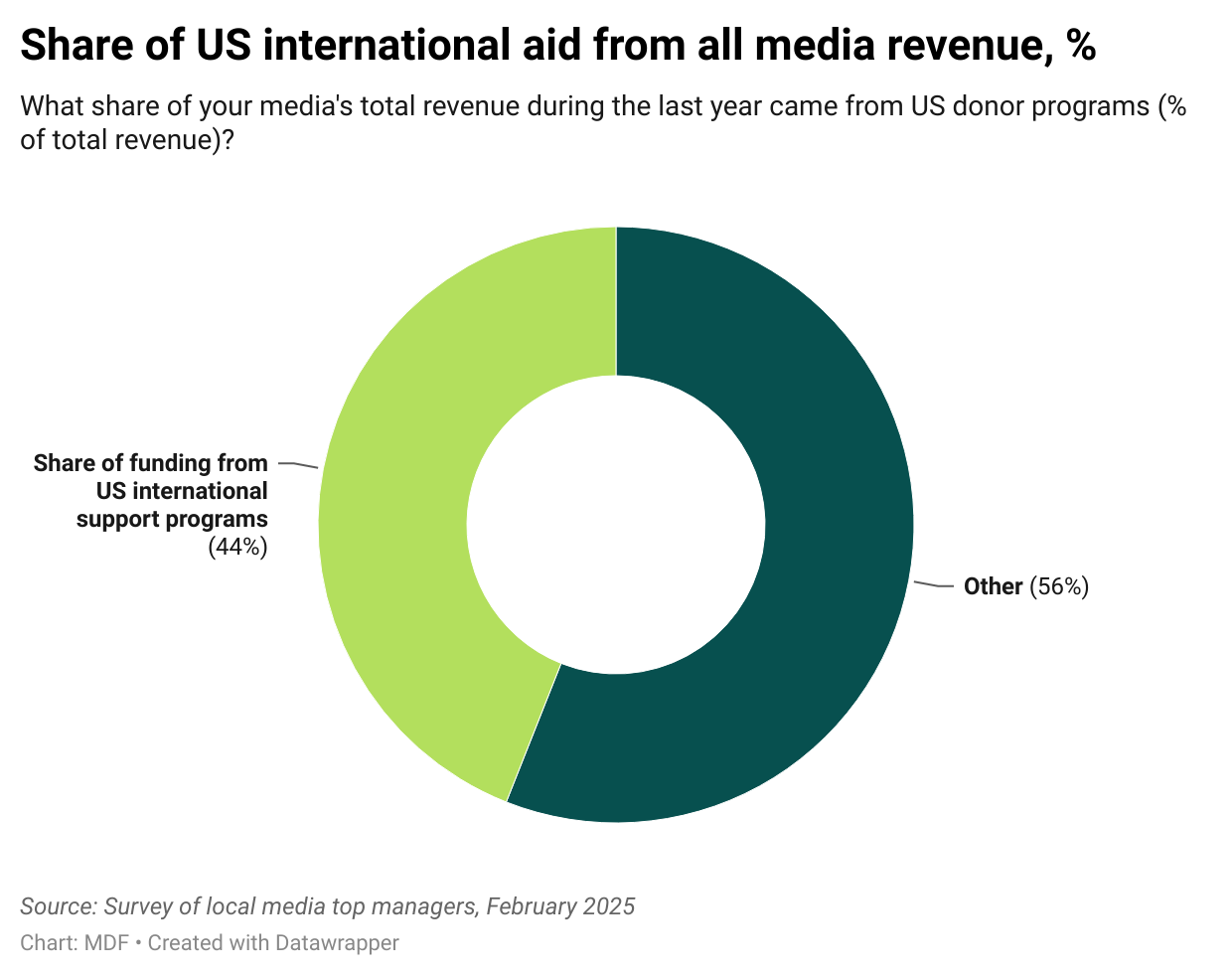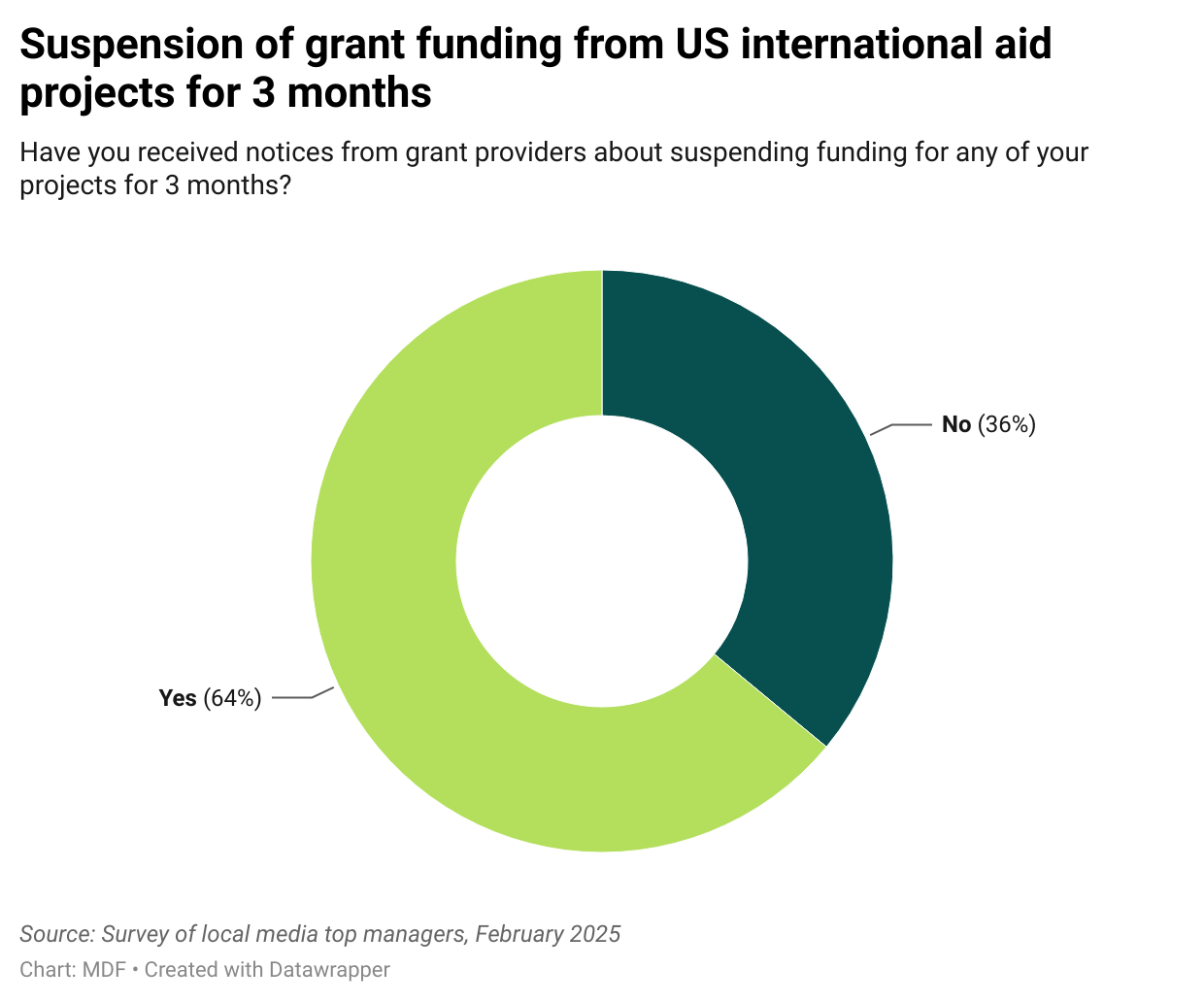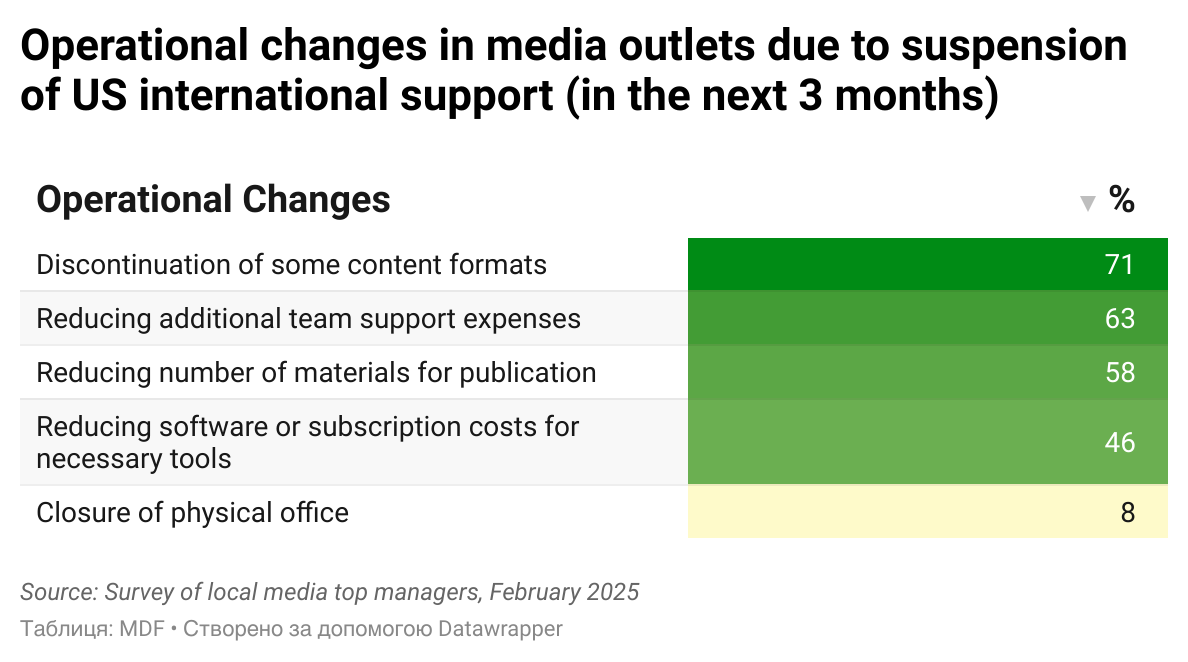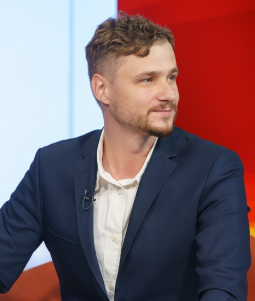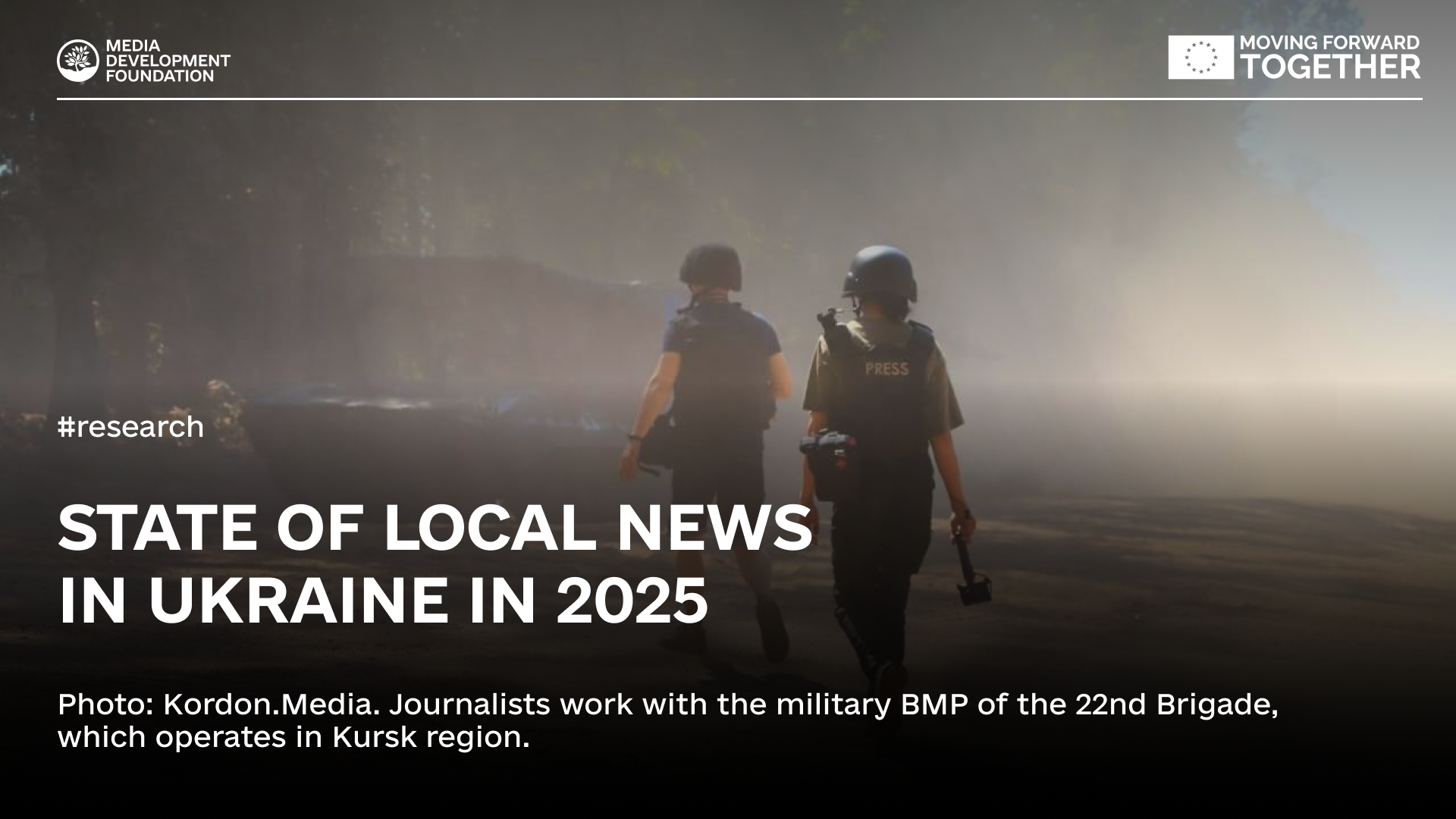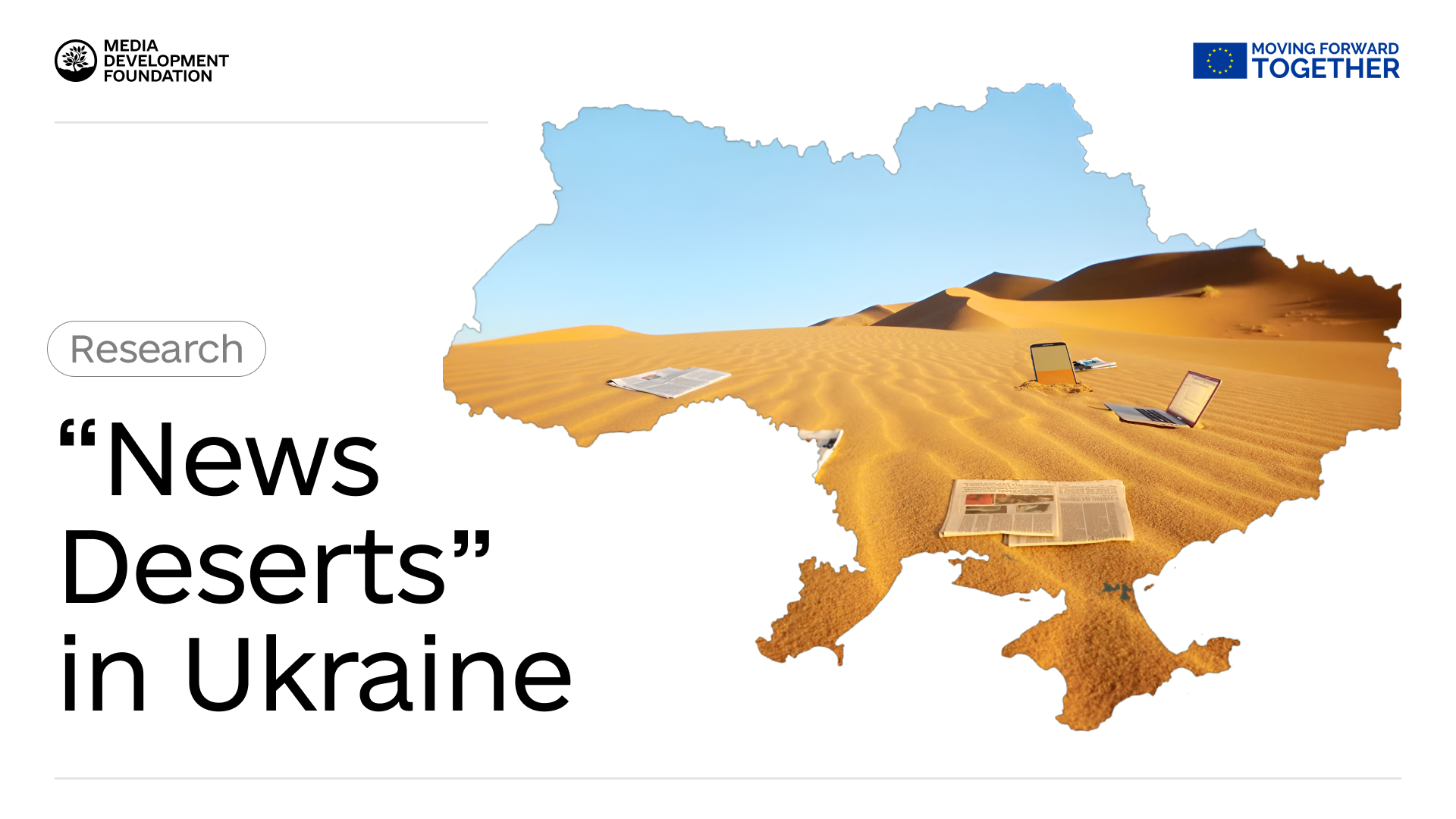The report analyzes the current situation and forecasts how the freeze of financial support from the US government will affect Ukrainian regional newsrooms.
Summary
| General background | Ukraine’s media sector is critically dependent on funding from US donors, which raises systemic risks to its stability. The most sensitive are local media, especially in the frontline regions of the eastern and southern regions of the country, where the ongoing security and economic crisis posed significant limitations on the possibility of diversifying funding sources.
|
| Forecast | The vast majority of newsrooms assess the situation as negative, although they see opportunities for overcoming the crisis within a 90-day period. The main concern is not so much the short-term suspension of funding as the long-term perspective. There are doubts about the resumption of funding from US agencies after a three-month period. At the same time, expectations of quick assistance from European donors seem doubtful, due to the bureaucratic specifics of the EU and a significantly lower anticipated funding offer. In addition, representatives of the media sector are worried about a general decline in donor assistance from any international partnerships.
|
| Changes in the content | A significant narrowing of the diversity of content in local media is expected. It is likely that the media will focus only on basic and critical information materials. An overall decrease in the number of publications is predicted, which may lead to a decline in the quality of coverage of local events, community issues, and voices of vulnerable groups within the population.
|
| Operational changes | Publishers plan to optimize operational costs by saving on additional work tools or software. In some cases, the closure of physical offices is being considered. These changes may negatively affect the technical capabilities of the newsrooms and their operations.
|
| Staff changes | For now, media outlets are trying to retain their core teams; however, some are already predicting or even implementing cuts, and a reduction in the use of freelancers and salaries is also anticipated. However, even if massive layoffs do not start in the near future, there is a risk of a talent drain due to financial instability and reduced team motivation.
|
| Impact on democracy | The weakening of local journalism could lead to a critical decline in community (hromada) awareness, especially where the media have been mainly funded by American foundations or their grantees. In the absence of an advertising market due to low business activity, media organizations will face a reduction in their capacities or potential closures.. This poses a threat to democratic processes at the local level, weakens public oversight of local authorities, and may contribute to the spread of disinformation.
|
Introduction
On January 25, 2025, by the order of U.S. Secretary of State Marco Rubio, support programs from the U.S. Agency for International Development (USAID) were completely suspended for 90 days, including support for Ukraine. Although the decline in donor funding was generally anticipated, no one expected such a sudden and complete halt. It became a kind of “Black Swan” – a rare, unpredictable event with far-reaching consequences – for the Ukrainian media sector.
This decision had a serious impact on a large number of Ukrainian regional media outlets, as they temporarily lost grant funding from U.S. foreign aid programs. This suspension could lead not only to staff cuts and delayed salaries, but also the complete shutdown of independent newsrooms, especially in areas near the front line, where opportunities to attract local advertising or support from businesses and readers are severely limited due to the difficult economic situation.
A survey of journalists conducted by the Institute of Mass Information (January 27-February 2, 2025) revealed an alarming trend: almost 60% of respondents predict devastating consequences following the termination of US donor assistance, which could lead to the closure of numerous media outlets. The analysis demonstrates the critical dependence of Ukrainian media on US grant support: in the absence of donor funding for six months, one-third of the surveyed newsrooms announced possible closure, and in a year without US support; this figure rises to 51%.
To analyze the impact of this situation on local media in greater depth, the Media Development Foundation’s research department conducted a targeted survey. We focused on the opinions of managers responsible for making strategic decisions in local newsrooms. In particular, we interviewed 42 top managers of local media. This survey was conducted as an additional component of the annual State of Local News in Ukraine 2025 study, which will be published in March this year (last year’s report is available here), using a semi-structured online questionnaire.
This report presents the findings of a study on the potential impact of suspending funding from U.S. government support programs on local newsrooms across different regions of Ukraine.
Scale of impact
The pause in grant funding from the United States puts significant pressure on Ukraine’s media sector, with local and hyperlocal newsrooms at particular risk. During the period of full-scale war, the sources of income for local media have significantly decreased due to the closure of local businesses and large-scale internal and external migration. Consequently, in recent years, donor support has become the most crucial for regional newsrooms, with about half of their financial income coming from grantors. As a result:
- The surveyed media outlets indicated that, in 2024, the share of their funding from US programs averaged 44% of their total newsroom revenues
- In turn, the share of American international aid amounted to 49% of all donor grants awarded to newsrooms.
Share of US international aid from all media revenue, %
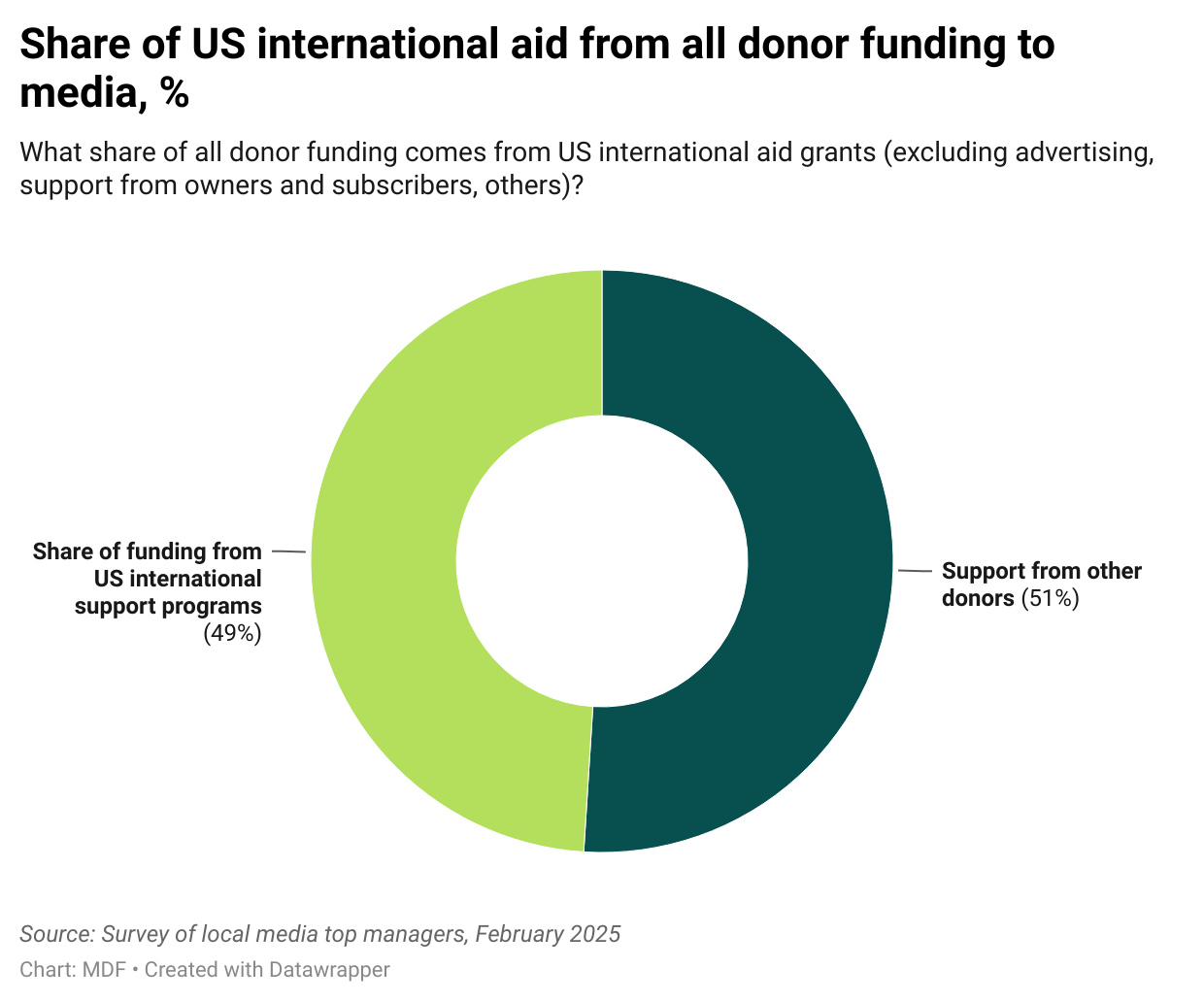
In January of this year, 64% of the regional media we surveyed received notifications that their project funding (or institutional support) had been suspended for three months by American donors who were covered by the US Presidential Decree on International Assistance.
Susupension of grant funding from US international aid project for 3 months, %
Analysis of the impacts
The overall effect of the temporary suspension of funding is viewed negatively by most newsrooms. 88% of the surveyed newsrooms characterize the situation as negative but with the possibility of finding a way out. As of today, we know for sure about one newsroom (4%) that has already suffered serious consequences, prompting management to reduce staff so soon. Only 8% of media outlets assess the situation as neutral, as they have the resources to replace the lost funding from other sources.
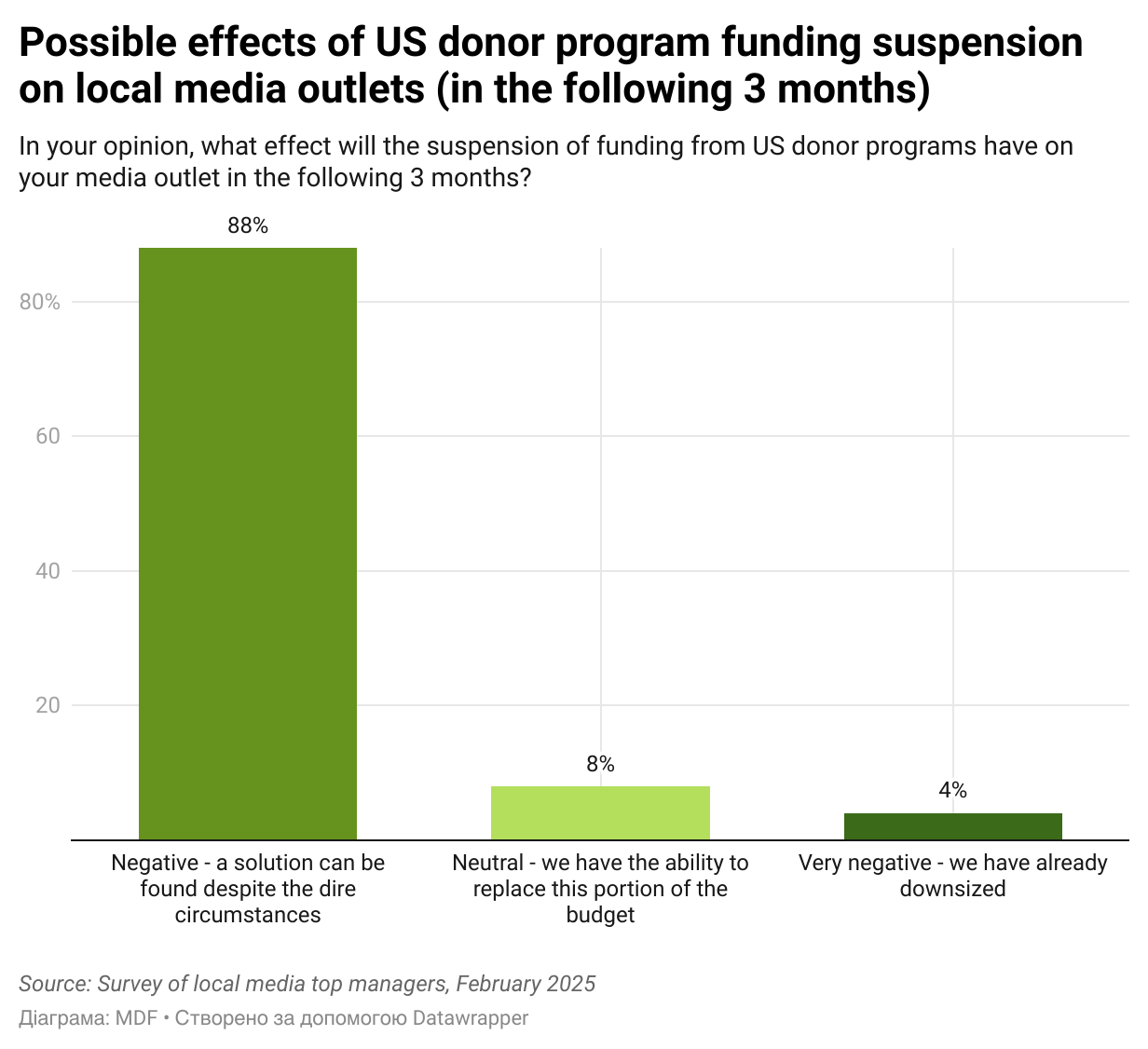
There is a clear correlation between the share of US funding and the expected negative impact on media operations. Media outlets with a higher share of US grants in their budgets (greater than 60%) expect more severe operational impacts and express greater concerns about long-term sustainability.
However, even media outlets with a smaller share of U.S. funding express concern about the general trend of decreasing grant support for Ukrainian initiatives.
At the time of the USAID funding freeze, we had only two small projects, the closure of which did not significantly impact the staff much. However, we have been awaiting new large projects since the spring, and we have been actively applying for new grants. In the long run, we risk stagnating in our development.
The media network from the west of Ukraine
The interviewed media managers express greater concern about the long-term future than the three-month suspension of grant funding. While they mostly believe that temporary economic difficulties “can be survived,” they are uncertain whether American support will be restored in 90 days.
The main issue is not even three months; they can still be passed. I am more afraid of the long-term situation.
The newsroom from the south of Ukraine
We do not really hope that funding will resume in 90 days. We will base our further decisions and steps on this.
The newsroom from the West
In addition, there is uncertainty about future models of international support in general. According to one media executive, the pause in USAID activities reflects a broader political transformation in the United States. Concurrently, there is a growing conservative trend in some European Union countries that may affect donor priorities. Moreover, when considering the EU as an alternative source of funding, it is worth taking into account the decision-making procedures that make it difficult to quickly deploy new funding programs that could systematically replace US support.
The aforementioned data demonstrate the dependence of Ukrainian journalism on foreign donors. For example, let’s look at previous MDF studies, such as The Donor Dilemma, which shows that local media in Ukraine are critically dependent on donor support.
The full-scale invasion has led to a significant reduction in the advertising market, which is recovering extremely slowly. Opportunities for reader support are also limited, as most Ukrainian donations are directed to defense needs. Under these circumstances, the sharp decline in donor support poses a serious threat to the further functioning of local media.
Operational changes
In the face of a dramatic change in the financial situation, newsrooms are trying to maintain their basic operating capacity, sacrificing additional activities and journalistic formats.
In order to optimize costs, first of all, newsrooms are going to stop producing certain content formats, as was reported by 71% of media managers surveyed. This indicates that the most effective formats will be prioritized and experimental or resource-intensive projects will be abandoned. In addition to narrowing down the types of content, 58% of newsrooms predict a decrease in the number of materials for publication.
63% plan to reduce additional costs to support the activities of the team. A slightly smaller share (46%) will cut budgets for software and subscriptions to technical tools. The most radical step – closing physical offices – is still planned by only 8%, or 2 newsrooms.
Human resources solutions
The analysis shows that local newsrooms tend to stick to the strategy of keeping their core teams as long as possible.
The management of newsrooms will first of all stop hiring freelancers – 67% of respondents said this. However, a reduction in salaries and bonuses is very likely (67% of respondents also mentioned this).
In the near future, 38% of newsrooms plan to cut staff. And while most are trying to keep key specialists even in the face of financial pressures, a significant number of media managers consider dismissal as a possible option.
The critical indicator – a complete shutdown of the newsroom within the next 3 months – is 4%, meaning that only one newsroom sees the potential effects in this way. This demonstrates the readiness of Ukrainian local media to work even in extremely unfavorable circumstances. However, these statistics may change if economic restrictions last longer than the planned 90 days.
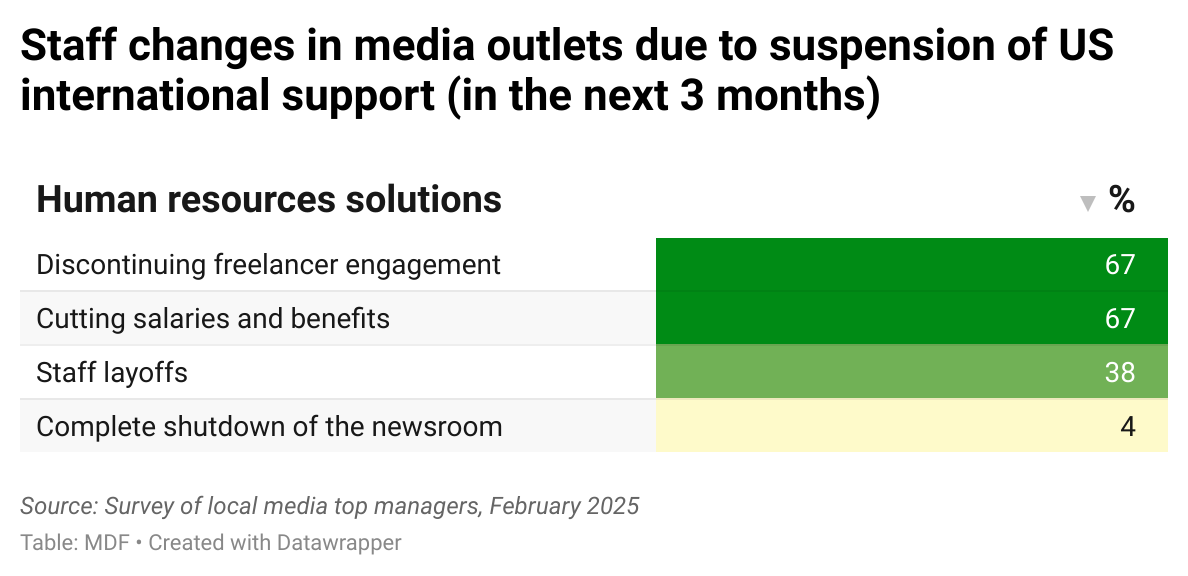
Psychological effect
The study revealed a significant impact of financial instability on the psychological state of media workers. 79% of newsrooms directly mention the demotivation of their staff, but a qualitative analysis of the respondents’ comments points to even deeper problems.
The key stressor is the uncertainty of long-term future prospects. Even newsrooms that remain operationally sustainable face serious challenges in keeping employees motivated.
A particular challenge is that psychological pressure can lead to an outflow of qualified staff who will seek more stable employment opportunities. This poses long-term risks to the quality of journalism and the media’s ability to fulfill its social function.
Regional breakdown
The most critical situation is observed in the media landscape of Eastern and Southern Ukraine, where there is the highest concentration of media outlets with a share of US donor funding of more than 60%. This is especially important given that most of these media outlets operate in frontline regions where alternative sources of funding are limited due to weak economic activity and a difficult demographic situation.
Media in the East of Ukraine have the largest share of funding from American donors, averaging 77% of all revenues. This may also be the reason why they are most sensitive to the situation with the freezing of US international aid. The potential effect of this is described by these media outlets as negative or very negative. Based on this situation, the management of eastern newsrooms is more likely than other regional media to consider serious staff changes, such as reducing salaries for their employees, reducing staff, and refusing to hire freelancers. Also, almost all of the interviewed eastern media outlets report an extremely low level of team motivation due to a sense of instability.
Meanwhile, southern newsrooms also have a fairly high level of insecurity. The share of US grants in these media outlets in 2024 averaged 45% of all revenues. Although the heads of these media outlets do not foresee any major staff cuts in the near future, they say they will have to optimize their team budgets (including salary cuts) and additional expenses.
Conclusions
The freezing of US foreign aid has created a critical situation for the Ukrainian media sector, especially for local media. Newsrooms are forced to implement tough cost-saving measures, which affects the quality and quantity of content, operational capacity, and human resources policies. The biggest concern is that the current crisis may have long-term consequences that will go far beyond the three-month period of suspension of funding.
The situation requires urgent diversification of funding sources for local media and the development of more sustainable business models. Without proper support, the weakening of local newsrooms can lead to an information vacuum in communities and weakening of democratic processes at the local level, which is especially dangerous in the context of war and active Russian propaganda.
Recommendations
Recommendations for donor organizations and institutions in the field of independent media development.
Expand funding sources for local media.
- Advocate for the inclusion of media support in Ukraine’s key assistance and reconstruction programs.
- Intensify efforts to attract new international and private donors and partners to stabilize the financial system of independent media in Ukraine.
- Implement co-financing mechanisms to combine resources from multiple foundations and reduce dependence on major donors.
- Develop crowdfunding and charitable contributions from local communities, strengthening engagement between media and their audiences.
Establish a consolidated fund to support independent local media.
- Pool resources from multiple donors into a unified fund capable of flexibly distributing financial support to various local media outlets.
- Establish an independent expert evaluation mechanism with transparent selection procedures and clear criteria for granting assistance.
Prioritize institutional support for newsrooms.
- Shift funding from short-term projects to covering operating expenses, salaries, and infrastructure development.
- Grant media outlets the flexibility to allocate funds according to their strategy and local context.
- Establish a strategic planning requirement to enable media outlets to strengthen their business models and diversify revenue sources.
Invest in reader engagement programs and marketing for independent media.
- Promote the growth of paid subscriptions, membership programs, crowdfunding, and voluntary contributions to reduce reliance on grant funding.
- Support marketing initiatives that foster audience loyalty and strengthen the brand of independent local media.
- Offer guidance and training on sales strategies, fundraising, and effective communication with potential subscribers.
Guidelines for independent local media
Independent media need to urgently implement a set of measures to maintain the viability of their key processes.
In quality management, a crisis response approach known as a corrective action plan involves pressing the “red button” to regain control of a process. Media managers should take a step back and critically assess the situation.
If a media outlet lacks reliable sources of monetization, it should evaluate its losses and suspend any activities that do not align with its core business model, whether grant-based or commercial.
Currently, local media often continue projects even after being informed that funding will not be restored. This serves as a good test of whether they were genuinely committed to journalism and providing audiences with a comprehensive picture of the day. So far, there hasn’t been a widespread suspension of projects, indicating that most newsrooms have remained active and continue to serve their communities. However, continuing unfunded projects is not a sustainable strategy. This crisis will be difficult to simply “wait out,” so media organizations should consider shutting down projects that no longer receive funding.
Therefore, it is now advisable to conduct a thorough critical assessment of the current situation, consider the possibility of temporarily suspending cooperation with employees whom the media outlet can no longer sustain, stabilize the team, and only then explore possible solutions to overcome the crisis.

